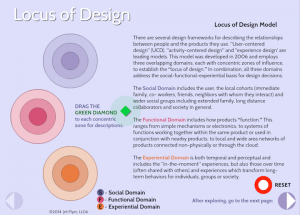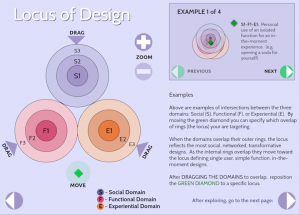This is an interactive exercise for understanding design as an intersection of domains representing social factors, functional capabilities and experiences. It was developed by former design professor Greg Daigle in 2006 and first appeared in Core77. It has also appeared in the ebook “Gravity 2.0.”
There are several design frameworks for describing the relationships between people and the products they use. “User-centered design” (UCD), “activity-centered design” and “experience design’ are leading models. This model was developed in 2006 and employs three overlapping domains, each with concentric rings of influence to establish the “locus of design.” In combination, all three domains address the social-functional-experiential basis for design decisions.
The Social Domain includes the user, the local cohorts (immediate family, co- workers, friends, neighbors with whom they interact) and wider social groups including extended family, long distance collaborators and society in general.
The Functional Domain includes how products “function.” This ranges from simple mechanisms or electronics, to systems of functions working together within the same product or used in conjunction with nearby products, to local and wide area networks of products connected non-physically or through the cloud.
The Experiential Domain is both temporal and perceptual and includes the “in-the-moment” experiences, but also those over time (often shared with others) and experiences which transform long-term behaviors for individuals, groups or society.
On the first screen users have the option to explore the different concentric circles of each domain to see what they represent.
In subsequent screens the user can select settings from each of the domains and see how the concentric domains move into place to represent the overlaps. Users can also drag the concentric domains until they overlap and view the outcomes… or take an interactive quiz to show if you understand the concept fully.
The interactive version of the app for desktops was build with ZebraZapps. See it below… (may take a full minute to load).
Be sure to click on the “Z” in the corner to see your viewing options to zoom to full screen.
The app is also available on Google Play for android devices: Locus of Design.
Explore how any design situation can be described as an overlapping set of three domains that determine the “locus” of design.


